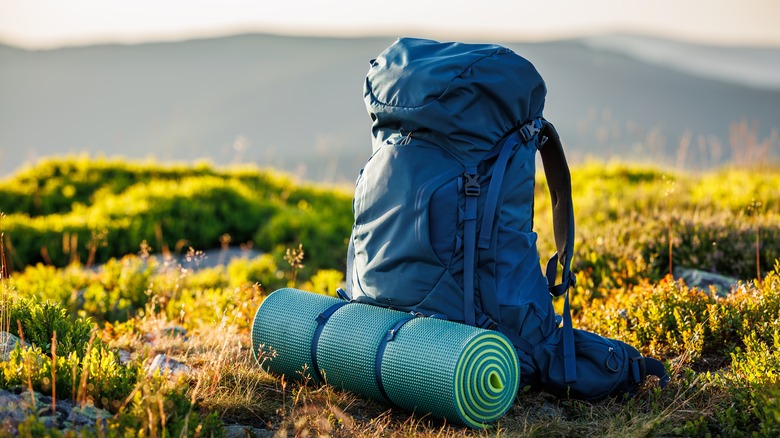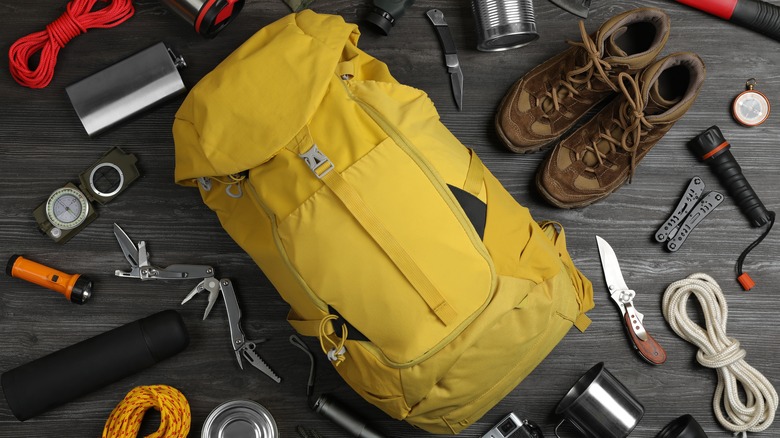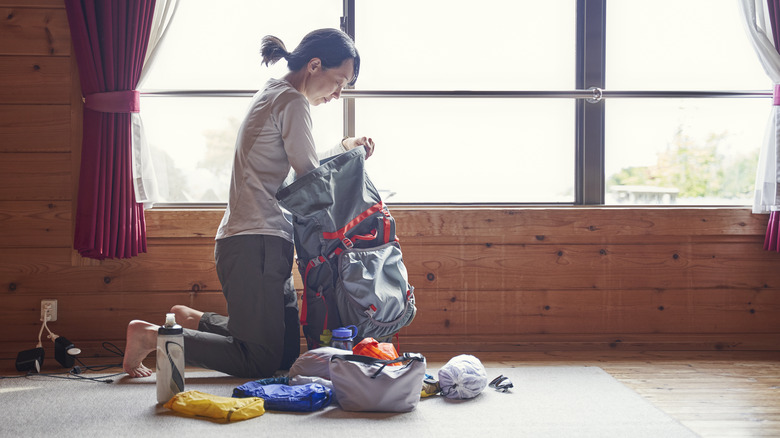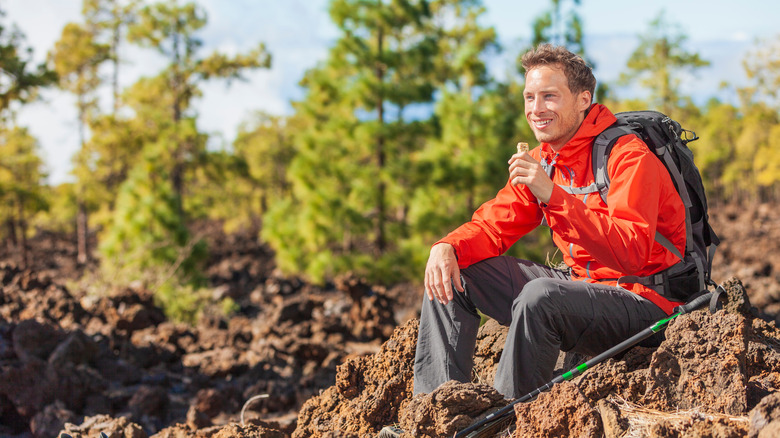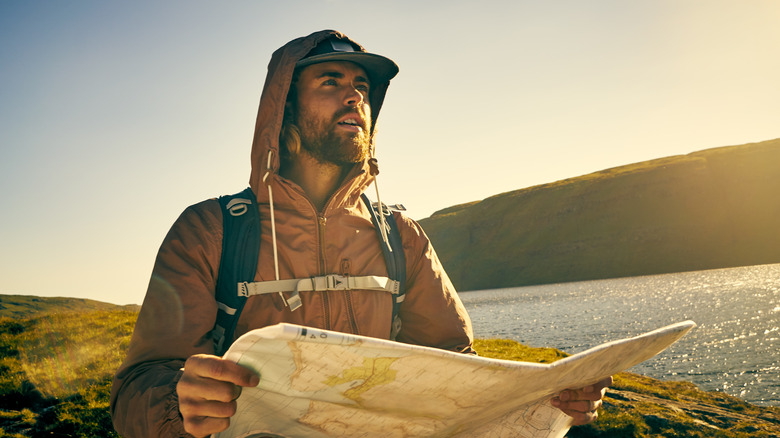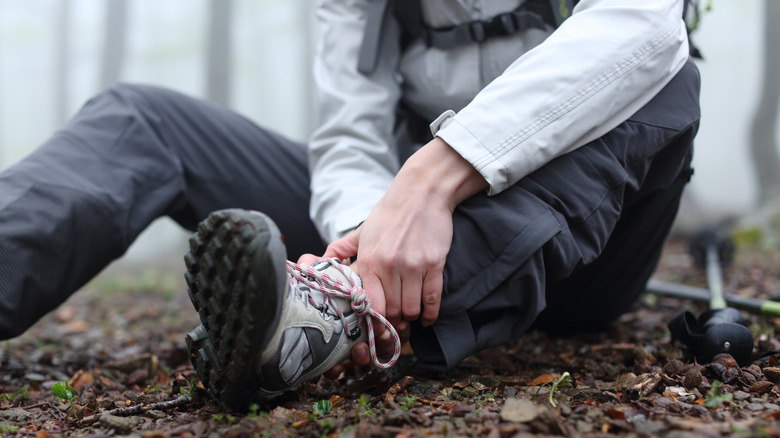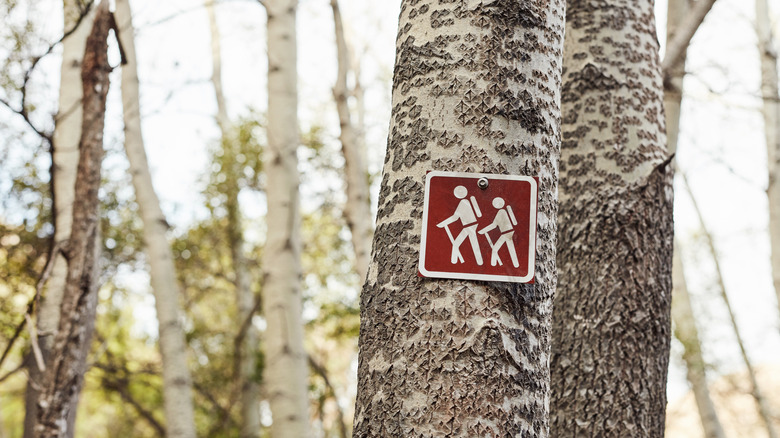The 8 Biggest Mistakes To Avoid When Packing For A Hike
Embarking on a hiking adventure holds the promise of fresh air, stunning landscapes, and a liberating connection with nature. However, against the lure of the great outdoors, the significance of proper packing is often underestimated. What begins as an exhilarating endeavor can swiftly transform into a challenging ordeal when essentials are overlooked, gear is misplaced, or the weight of your backpack becomes a burden. The trail to a successful hike is paved with thoughtful preparation, and this journey begins with a well-organized and carefully curated backpack.
In this article, we're exploring the often underrated, yet crucial aspect of hiking — packing. It's something that even experienced hikers may forget to prioritize prior to embarking on their journey. As journalist Cassandra Brooklyn wrote for Business Insider after her 96-mile hike in Scotland, "I've hiked thousands of miles, yet there were certain things I hadn't considered I'd need until now."
From the meticulous arrangement of gear to the strategic selection of essentials, we'll highlight the pitfalls to avoid, ensuring that your next hiking expedition is not only memorable, but also devoid of unnecessary challenges.
Using a generic packing list
Every trail, whether winding through dense forests, ascending rugged mountains, or meandering along serene lakeshores, possesses its own unique set of challenges and surprises. One of the gravest errors a hiker can make is adhering to a generic, one-size-fits-all packing list. To truly conquer the trail, it's imperative to tailor your packing approach to the specific demands of the journey.
To begin, understand your trail conditions. The terrain you'll encounter plays a pivotal role in determining your packing priorities. For example, a rocky mountain ascent demands sturdy footwear and possibly trekking poles, while a gentle riverside path might require waterproof gear. Addressing these nuances ensures that your packing list aligns seamlessly with the challenges that lay ahead.
In addition to the demands of your trail, acknowledge your own unique physical and psychological needs. Just as no two hikes are alike, no two hikers share the exact same preferences and requirements. Your level of comfort significantly influences the enjoyment of the journey. Whether it's a specific dietary need, a preference for certain gear, or a requirement for additional creature comforts, acknowledging and addressing individual needs allows for a more personalized and enjoyable hiking experience.
Packing gear inefficiently
The art of efficient gear packing isn't just about fitting everything inside your backpack; it's about creating a harmonious balance between accessibility, organization, and maximizing the limited space available. As you embark on your hiking expedition, the manner in which you pack your gear can significantly impact the ease of your journey.
Often, what hikers fail to do is maximize their space. The backpack becomes your mobile home on the trail, and every square inch counts. But no — we're not talking about filling your backpack to the brim. Inefficient gear packing often stems from neglecting the potential of your backpack's various compartments. This oversight can lead to a frustrating search for essentials or, worse, unnecessary unpacking and repacking.
Picture this: you're halfway up a challenging ascent, and a sudden downpour prompts the need for your rain jacket. The last thing you want is to be fumbling through a disorganized backpack, disrupting the flow of your hike. Instead, place frequently needed items in easily reachable pockets and grouping gear by functionality, making every item effortlessly accessible.
Overpacking and not balancing your backpack
As you prepare to venture into the great outdoors, the weight on your back holds the key to the comfort and success of your hiking expedition. The allure of packing for every possible scenario can be tempting, but it often leads to overpacked backpacks that burden rather than assist hikers. Instead, delve into the art of minimalist packing, which encourages hikers to optimize their load for a more comfortable, stable, and enjoyable hiking experience.
Minimalist packing isn't about deprivation; it's about intentionality. From selecting lightweight gear to multi-functional items that serve dual purposes, minimalist packing empowers hikers to shed excess weight without sacrificing comfort or preparedness. Minimalist packing also aids in load balancing. In fact, even with a light backpack, an uneven weight distribution can lead to muscle aches or injuries that can disrupt the harmony of your hike. When packing, be sure to balance the weight of your items evenly throughout your backpack. Where necessary, adjust the balance of items using compression straps for a more gratifying adventure.
Not planning nutrition
Embarking on a hiking adventure demands more than just a sturdy pair of boots and a well-packed backpack; it requires a thoughtful approach to nutrition. The mistake of neglecting proper meal planning can have a profound impact on your energy levels, endurance, and overall enjoyment of the journey. Adequate nutrition starts with before the hike. Neglecting this phase can leave you fatigued and struggling for energy right from the get-go. Never start your journey on an empty stomach. Instead, set out on your journey with an optimal nutritional foundation. Nourish your body with a pre-hike meal that combines complex carbohydrates for sustained energy, proteins for muscle support, and healthy fats for overall endurance.
Hiking demands sustained energy, and fueling on the go is a challenge many hikers face. The mistake of not planning snacks and meals for the trail can lead to energy dips and muscle fatigue — which, while outdoors, can be downright dangerous. From trail mix and energy bars to dried fruit and nuts, maintain optimal performance throughout your hike by packing lightweight, nutrient-dense snacks that can be easily carried and consumed on the trail.
Last, the end of the trail is not the finish line for your nutritional considerations. For mountain climbers, remember that the end of your ascent is only halfway through your journey. The mistake of neglecting post-hike nutrition can impact recovery and future performance. It's important to replenish glycogen stores and repair muscles with protein with post-hike meals and snacks to ensure you are ready for your next outdoor adventure.
Inadequately strategizing hydration
It's easy to overlook the sheer amount of fluid your body requires when embarking on a hiking adventure. The mistake of underestimating water needs can lead to dehydration, resulting in fatigue, dizziness, and even more severe health complications. In addition, individual hydration requirements change based on factors such as climate, altitude, and personal exertion levels. By addressing this common oversight, hikers can take the first step toward ensuring their bodies are adequately fueled for the journey ahead.
While on the trail, staying hydrated isn't just about carrying a water bottle; it involves strategic planning and mindful consumption. Overhydration can lead to discomfort and unnecessary bathroom breaks disrupting the fluidity of your hike, and potentially setting you behind schedule. On the other hand, the consequences of inadequate fluid intake extend beyond mere discomfort.
Establish a hydration schedule, choosing an appropriate water-carrying system, and incorporating hydrating snacks into the adventure. From sipping water consistently throughout the hike to recognizing early signs of dehydration, it's important to maintain optimal fluid balance since dehydration can impair physical and cognitive performance, compromise judgment, and even lead to serious health issues.
Only packing a phone for navigation
The fear of losing one's way in the wilderness is primal and deeply rooted. Relying solely on technology, however sophisticated, introduces an element of vulnerability that can escalate this fear into a genuine concern. Putting blind trust in electronic navigation can mislead you as not all applications are up-to-date or accurate. In addition, electronic devices put you at risks associated with technology failures, such as battery depletion, signal loss, or device malfunctions.
Maps, compasses, and GPS devices stand as timeless companions and indispensable tools in the outdoor world. Each tool serves a unique purpose. A well-folded map provides a holistic overview of the terrain, a compass acts as a steadfast directional guide, and a GPS device offers real-time location tracking.
However, possessing navigation tools is only half the battle; the other crucial component is knowing how to use them effectively. Learn how to read topographic maps, orient a compass, and maximize the features of a GPS device. This way, you are equipped to confidently traverse unfamiliar terrains, identify key landmarks, and recalibrate your course when necessary.
Failing to check gear condition
The excitement of embarking on a hike often overshadows the need for meticulous gear checks. However, failing to scrutinize the condition of your equipment can lead to a cascade of issues, from uncomfortable blisters caused by worn-out boots to critical gear failures on the trail.
Understanding the condition of your gear is akin to knowing the reliability of your trail companion. Pre-trip gear inspections are necessary. Begin by examining the structural integrity of your backpacks. Then, ensure the functionality of crucial tools and equipment so that you can identify potential issues and take corrective measures before setting foot on the trail.
In addition to checking gear condition, it's important to maintain your gear in good condition while hiking. The unpredictable nature of weather makes waterproofing essential gear a non-negotiable aspect of preparation. Unfortunately, many hikers commonly neglect waterproofing. Don't forget this key step and be sure to pack dry bags and protective covers to keep gear dry and functional.
Forgetting permits and regulations
As wonderful as it would be to freely hike all of nature's wonders, this isn't the reality of our world. Some parks, trails, and mountains require permits. These regulations are put in place to conserve natural spaces. Overlooking the need for permits can quickly turn the dreamy vision of a trail into a bureaucratic nightmare.
Always research and secure any necessary permits you require, whether these be to access trails, or to camp overnight. You may need different permits for different types of vehicles as well. Understanding the permit requirements for your chosen trail is a responsibility that extends beyond personal convenience. Hiking is not just a personal journey; it's a shared experience with the environment. Neglecting environmental regulations can disrupt the delicate balance of ecosystems, threatening the very landscapes hikers seek to explore. By adhering to these regulations, hikers not only avoid penalties, but actively contribute to the preservation of the natural beauty we cherish.
